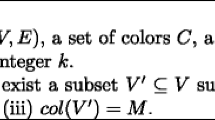Abstract
At the heart of the ideas of the work of Dutch graphic artist M.C. Escher is the idea of automation; we consider a problem that was inspired by some of his earlier and lesser known work. Specifically, a motif fragment is a connected region contained in a closed unit square. Consider a union of motif fragments and call the result an Escher tile T. One can then construct a pattern in the Euclidean plane, as Escher did, with the set of horizontal and vertical unit length translations of T. The resulting pattern gives rise to infinitely many sets of motif fragments (each set may be finite or infinite) that are related visually by way of the interconnections across boundaries of the unit squares that underly the construction; a set of related motif fragments sometimes gives the appearance of a ribbon and thus the resulting pattern in the plane is called a ribbon pattern. Escher’s designs gave rise to beautiful artwork and inspired equally aesthetic combinatorial questions as well. In his sketchbooks, Escher coloured the ribbon patterns with pleasing results. Colouring the ribbon patterns led naturally to a question of periodicity: is there a prototile that generates a well-coloured pattern? The current work answers the question in the affirmative by way of tools from graph theory, algorithms, and number theory. We end with tools to help address questions of optimization and a list of open questions.












Similar content being viewed by others
References
Berger, R.: The undecidability of the domino problem. Mem. Am. Math. Soc. 66, 72 (1966)
Cohen, E., Megiddo, N.: Recognizing properties of periodic graphs. In: Applied Geometry and Discrete Mathematics. DIMACS Ser. Discrete Math. Theoret. Comput. Sci., vol. 4, pp. 135–146. Am. Math. Soc., Providence (1991)
Cohen, H.: A Course in Computational Algebraic Number Theory. Graduate Texts in Mathematics, vol. 138. Springer, Berlin (1993)
Dan, D.: On a tiling scheme from M.C. Escher. Electron. J. Comb. 4(2), R23 (1997). Research Paper. Approx. 11 pp. The Wilf Festschrift (Philadelphia, PA, 1996)
Escher, G.: Potato printing: a game for winter evenings. In: Coxeter, H.S.M., Emmer, M., Penrose, R., Teuber, M. (eds.) M.C. Escher: Art and Science, pp. 9–11. North-Holland, Amsterdam (1986)
Fowler, J.J., Gethner, E.: Counting Escher’s m×m ribbon patterns. J. Geom. Graph. 10(1), 1–13 (2006)
Gardner, M.: Penrose Tiles to Trapdoor Ciphers and the Return of Dr. Matrix. MAA Spectrum. Math. Assoc. of America, Washington (1997)
Gethner, E.: On a generalization of a combinatorial problem posed by M.C. Escher. In: Proceedings of the Thirty-Second Southeastern International Conference on Combinatorics, Graph Theory and Computing, Baton Rouge, LA, 2001, vol. 153, pp. 77–96 (2001)
Gethner, E., Kirkpatrick, D.G., Pippenger, N.: M.C. Escher wrap artist: aesthetic coloring of ribbon patterns. In: FUN, pp. 198–209 (2012)
Gethner, E., Schattschneider, D., Passiouras, S., Fowler, J.J.: Combinatorial enumeration of 2×2 ribbon patterns. Eur. J. Comb. 28(4), 1276–1311 (2007)
Itten, J.: The Art of Color: the Subjective Experience and Objective Rationale of Color. Wiley, New York (1974)
Mabry, R., Wagon, S., Schattschneider, D.: Automating Escher’s combinatorial patterns. Math. Educ. Res. J. 5, 38–52 (1996)
Osborne, H.: The Oxford Companion to Art. Clarendon, Oxford (1970)
Pisanski, T., Schattschneider, D., Servatius, B.: Applying Burnside’s lemma to a one-dimensional Escher problem. Math. Mag. 79(3), 167–180 (2006)
Robinson, R.M.: Undecidability and nonperiodicity for tilings of the plane. Invent. Math. 12, 177–209 (1971)
Schattschneider, D.: Escher’s combinatorial patterns. Electron. J. Comb., 4(2), R17 (1997). Research Paper. Approx. 31 pp. The Wilf Festschrift (Philadelphia, PA, 1996)
Schattschneider, D.: M.C. Escher: Visions of Symmetry. Harry N. Abrams, New York (2004)
Sysło, M.M.: On cycle bases of a graph. Networks 9(2), 123–132 (1979)
van Emde Boas, P.: The convenience of tilings. In: Complexity, Logic, and Recursion Theory. Lecture Notes in Pure and Appl. Math., vol. 187, pp. 331–363. Dekker, New York (1997)
Wang, H.: Notes on a class of tiling problems. Fundam. Math. 82, 295–305 (1974/75). Collection of articles dedicated to Andrzej Mostowski on his sixtieth birthday, VIII
Acknowledgements
The authors wish to thank Anne Condon, Will Evans, Joel Friedman, and Doris Schattschneider for their interest, helpful insights and support for this project. The first author is grateful to Steve Ogden for his implementation of our algorithm in \(\mathbb{R}^{2}\) and \(\mathbb{R}^{3}\), and to Rick Mabry and Stan Wagon for interesting discussions about their work in [12]. We are grateful to M.C. Escher for his thought provoking ideas and beautiful designs; all of the Escher tiles in this article are adaptations of tiles originally designed by Escher. Penultimately, a shorter version of this article appeared in the conference proceedings of FUN with Agorithms 2012 [9], and we thank the organizers for the opportunity to expand our paper. Finally, we thank the referees for their helpful comments in the current version.
Author information
Authors and Affiliations
Corresponding author
Additional information
A version of this article with colour graphics can be found at http://cse.ucdenver.edu/~egethner/Papers/.
Rights and permissions
About this article
Cite this article
Gethner, E., Kirkpatrick, D.G. & Pippenger, N.J. Computational Aspects of M.C. Escher’s Ribbon Patterns. Theory Comput Syst 54, 640–658 (2014). https://doi.org/10.1007/s00224-013-9485-9
Published:
Issue Date:
DOI: https://doi.org/10.1007/s00224-013-9485-9




